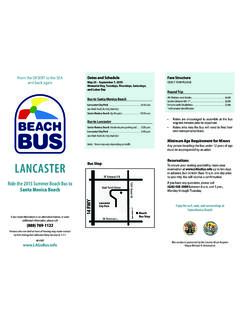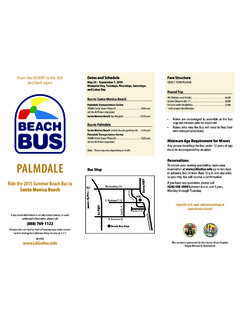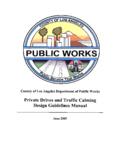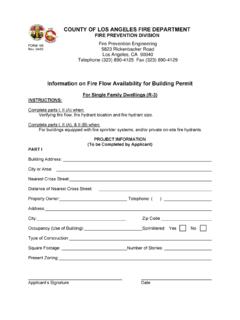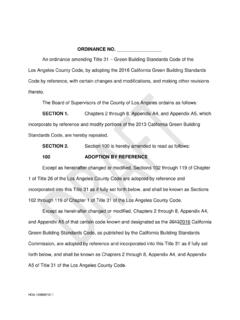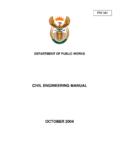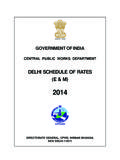Transcription of HYDROLOGY MANUAL - Department of Public Works, Los …
1 Los angeles county Department of Public WorksLos angeles county Department of Public WorksJanuary 2006 January 2006 HYDROLOGY MANUALHYDROLOGY MANUALLos angeles county Department of Public Works HYDROLOGY MANUAL Water Resources Division January 2006 Donald L. Wolfe, Director 900 South Fremont Avenue Alhambra, California 91803 Prepared By:Technical Assistant: Chris ConkleTechnical Assistant:Janelle MoyerProject Manager: Ben Willardson, Supervisor: Adam Walden, Director: Iraj Nasseri, , Committee:Martin Araiza, Do, Imaa, angeles county Department of Public WorksLos angeles county Department of Public WorksJanuary 2006 January 2006 HYDROLOGY MANUALHYDROLOGY MANUAL TABLE OF CONTENTS CHAPTER 1 Introduction 1 Purpose and Scope 1 Overview of Hydrologic Method 1 CHAPTER 2 Physical Factors Affecting HYDROLOGY 6 Topography 6 Geology and Soils 6 Vegetative Cover and Land Use 8 Climate 9 Hydrometeorologic Characteristics 11 Runoff Characteristics 12 CHAPTER 3 Major Watersheds and Tributaries 15 Los angeles River 16 San Gabriel River 18 Santa Clara River 21 Coastal 22 Antelope Valley 25 Table of Contents HYDROLOGY MANUAL ii January 2006 CHAPTER 4 Policy on Levels of Protection 27 Department
2 Policy Memorandum 27 Capital Flood Protection 27 Urban Flood Protection 30 Probable Maximum Flood Protection 31 National Flood Insurance Program 33 Compatibility with Existing Systems 34 Existing Level of Flood Protection 34 Multiple Levels of Flood Protection 34 CHAPTER 5 Rainfall and Design Storm Characteristics 36 Rainfall Intensity-Duration-Frequency 37 Unit Hyetograph 40 Rainfall Isohyets 42 Design Storm 43 Probable Maximum Precipitation (PMP) 48 CHAPTER 6 Rainfall-Runoff Relationships 49 Rainfall Losses and Runoff Production 49 Infiltration 49 Modified Rational Loss Calculations 50 Constant Loss Method 56 Table of Contents HYDROLOGY MANUAL iii January 2006 CHAPTER 7 Runoff Calculation Methods 58 Selecting the Proper Method 58 Rational Method 59 Modified Rational Method 60 Catch Basin Flow Calculations 77 Reporting Runoff Values 79 CHAPTER 8 Reservoir and Basin Routing 83 CHAPTER 9 Water Quality HYDROLOGY 90 Standard Urban Stormwater Mitigation Plans (SUSMP) 90 Total Maximum Daily Loads (TMDL) 93 Best Management Practices (BMPS)
3 95 Table of Contents HYDROLOGY MANUAL iv January 2006 CHAPTER 10 Hydrologic Data Requirements and Sources 98 Required Data 98 Data Sources 99 Field Reconnaissance 101 Watershed Delineation 103 Collecting Subarea Data 107 Collecting Rainfall Data 108 Conveyances 109 CHAPTER 11 Time of Concentration Calculation 111 Time of Concentration Hand Calculations 111 Time of Concentration - Tc Calculator 113 CHAPTER 12 Rational & Modified Rational Modeling 118 Watershed Model Creation 118 Rational Method 121 Modified Rational Method 126 Table of Contents HYDROLOGY MANUAL v January 2006 CHAPTER 13 Classification of Hydrologic Models 133 Event Versus Continuous Models 133 Lumped and Distributed Parameter Models 134 CHAPTER 14 Divisions With Hydrologic and Hydraulic Responsibilities 135 Building and Safety Division 135 Construction Division 137 Design Division 138 Environmental Programs Division 139 Land Development Division 140 Watershed Management Division 141 CHAPTER 15 Computer Programs for the Los angeles county HYDROLOGY Methods 142 Watershed Modeling System (WMS)
4 143 XP-SWMM 144 HEC-HMS 144 LAR04/RETARD 144 Table of Contents HYDROLOGY MANUAL vi January 2006 INDEX APPENDIX A Design Storm Unit Hyetograph APPENDIX B Hydrologic Maps APPENDIX C Soil Type & Runoff Coefficient Data APPENDIX D Proportion Impervious Data CHAPTER 1 Introduction PURPOSE AND SCOPE This MANUAL establishes the Los angeles county Department of Public Works' hydrologic design procedures and serves as a reference and training guide. This MANUAL contains charts, graphs, and tables necessary to conduct a hydrologic study within the county of Los angeles . Examples provide guidance on using the hydrologic methods. The primary purpose of this MANUAL is to explain the steps involved in converting rainfall to runoff flow rates and volumes using Public Works standards.
5 This MANUAL contains procedures and standards developed and revised by the Water Resources Division based on historic rainfall and runoff data collected within the county . The hydrologic techniques in this MANUAL apply to the design of local storm drains, retention and detention basins, pump stations, and major channel projects. The techniques also apply to storm drain deficiency and flood hazard evaluations. Low flow HYDROLOGY methods related to water quality standards are also discussed. This MANUAL compiles information from previous editions of the county of Los angeles HYDROLOGY MANUAL , the 2002 HYDROLOGY MANUAL Addendum, and other reference materials. The standards set forth in this MANUAL govern all HYDROLOGY calculations done under Public Works' jurisdiction.
6 Hydrologic procedures in manuals prepared for use by other Divisions within Public Works must be compatible with this MANUAL . OVERVIEW OF HYDROLOGIC METHOD The Los angeles county Flood Control District initiated its Comprehensive Plan in 1931. Engineers determined that the runoff data within the District was insufficient to create empirical runoff calculations due to limited stream flow data. Lack of stream flow data made it difficult to establish standards Chapter 1 - Introduction HYDROLOGY MANUAL 2 January 2006 and a hydrologic method based on runoff observations. Therefore, the engineers decided that computing design flows based on rainfall was necessary. A rainfall based hydrologic method was deemed more acceptable due to the availability of rainfall data.
7 Figure shows a rain gage used to collect rainfall data for hydrologic analysis. Using rainfall-runoff relationships, methods are developed to compute flow rates and define hydrographs based on a design storm event. The two rainfall-runoff methods that apply to HYDROLOGY studies within the county of Los angeles are the Rational and Modified Rational Methods. The use of these rainfall-runoff methods depends on the study requirements. The Rational Method, Q = CIA, is used for simple HYDROLOGY studies within the county of Los angeles . This method produces a peak flow rate and is only applicable to small areas. The Rational Method applies to development Figure Rain Gage #47D Located at Clear Creek School Chapter 1 - Introduction HYDROLOGY MANUAL 3 January 2006 of small areas when no storage volume information is required and overland flow is the primary collection method.
8 The primary method, in use since the 1930 s, is the Modified Rational Method (MODRAT). MODRAT is based on the Rational Method, but uses a time of concentration and a design storm to determine intensities throughout the storm period. The intensities are used to determine the soil runoff coefficient. The rational formula then provides a flow rate for a specific time. Plotting the time specific flow rate provides a hydrograph and an associated flow volume. MODRAT is the standard method for hydrologic studies within the county . Computer programs implement MODRAT to compute runoff data from input parameters. MODRAT relies on a design storm defined by a time-intensity relationship and a spatial precipitation pattern. The temporal and spatial distributions of rainfall used with MODRAT have changed over the years based on analysis of historic rainfall records.
9 A dimensionless design storm represents rainfall events commonly observed during major extratropical storms in the Los angeles area. The storm duration is four days. The maximum rainfall quantity occurs on the fourth day. Rainfall isohyets show the spatial distribution of rainfall over the county . The isohyets represent the depth of rainfall for a standard design frequency over a specified period of time. Multiplying the unit hyetograph by the rainfall isohyetal depth produces the design storm for a specific area. Figure shows rainfall isohyets in the county of Los angeles . This area-specific design storm and an area-specific time of concentration define the time-intensity relationship for a particular subarea. Each subarea requires an area specific time of concentration and design storm.
10 Chapter 1 - Introduction HYDROLOGY MANUAL 4 January 2006 Calculation of the time of concentration has evolved over time. Currently, time of concentration calculations rely on a regression equation based on the kinematic wave theory. Reservoir routing of hydrographs for storage uses the Modified Puls method. This method is based on a finite difference approximation of the continuity equation coupled with an empirical representation of the momentum This method is widely used for reservoir routing in hydrologic studies and is the approved method for use within the county of Los angeles . Figure 50-year, 24-hour Rainfall Isohyets in the county of Los angeles Chapter 1 - Introduction HYDROLOGY MANUAL 5 January 2006 Figure shows Morris Reservoir located in the San Gabriel Mountains.


